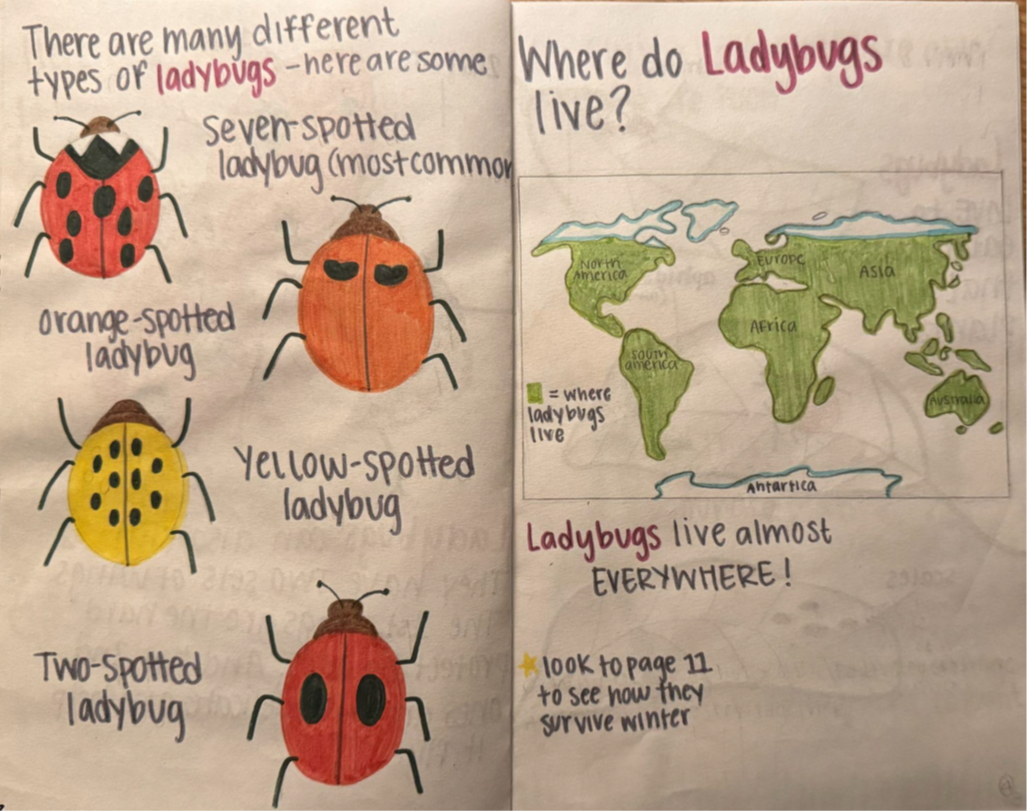Mutual Learning, Mutual Healing: Benefits of Inter-school Writing
By Sarah Hart Micke, Georgia Bruno, Linnea Cervenka, Sophia Cornell, and Julia Weill
“Writing is an incredibly powerful tool; however, we are taught, if inadvertently, to despise it and view it as a task rather than something positive,” explains DU WRIT student Sophia Cornell. For 9 years, Sarah Hart Micke’s WRIT classes have revitalized writing through our DU-Charles Hay World School partnership. Once a week, DU WRIT students and elementary writers collaborate in small groups in which everyone shares feedback on each other’s writing, including DU students’ children’s books and parent newsletters. For example, our photos feature Linnea Cervenka’s ladybug book for her 2nd-graders. But the benefits of our collaborative writing extend beyond increasing intellectual knowledge. We forge personal connections that also enhance everyone’s emotional intelligence and, sometimes, even emotional healing.
This year, CCESL supported our partnership through a Community-engaged Student Assistant - DU senior Georgia Bruno. As a mentor to Sarah’s first-year WRIT classes, Georgia supported DU students and Charles Hay small groups, gaining unique insight into our partnership’s intellectual and emotional benefits. For example, Georgia reflects:
All quarter, I floated among the small groups collaborating at Charles Hay, checking in with the DU group leaders and supporting elementary students. I was particularly struck by how a child’s limited self-regulation skills can create learning challenges. On our last day, two DU co-leaders from the same group were out sick, leaving their mentees with no familiar leader for the day - and most importantly, with no opportunity to say good-bye to their adored co-leaders. I saw the 2nd-graders immediately look around for their DU buddies and, after I told them their buddies were absent, they were overwhelmed with tearful emotions. With help from Sarah and their 2nd-grade teachers, the students re-regulated their emotions through writing and drawing. I observed them calming their minds and bodies.
None of us - students and teachers alike - expected our emotional stability to be tested the way it was that day. Yet we all learned together how to best help the 2nd-graders accept the reality of the situation - and learned about our own emotional responses in the process. As a Criminology major and Psychology minor, this is what I want to learn how to do - to provide methods for youth of all backgrounds to cope with inevitable unfair situations that arise throughout life. I want to help kids build an emotional foundation that makes coping strategies a positive habit for maintaining their sense of self in the face of adversity.
By fostering such meaningful relationships, our partnership enhances learning about both emotions and writing - and invites collaborators to experience writing as a healing process. For example, reflecting on her experiences this Winter 2024, Sophia explains, “When one of the [2nd-grade] students . . . was losing confidence as they struggled to read . . . I was eager to help them . . . When I got the chance to produce my own writing . . . . [for] them, I felt excited . . . about a writing assignment for the first time in a long time.” Likewise, jaded by rigid writing rules from prior classes, Sophia’s classmate Julia Weill articulates a similar sentiment: “Through my efforts to initiate beneficial writing perceptions for my second graders, I healed my exhaustion for writing, and reminded myself that it can be . . . lighthearted and motivated.” Through such collaborations, writing becomes an avenue for humanizing the learning process and encourages all collaborators to approach their education with more creativity and hope.

